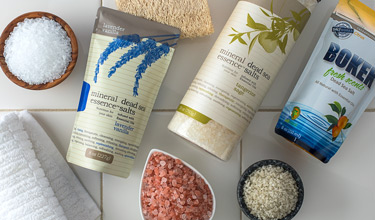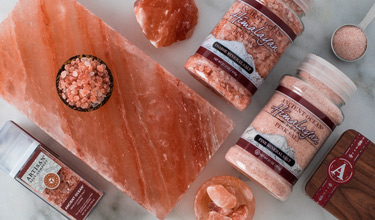Serious about salt
SaltWorks® is truly serious about salt—which is why we take the time and care to educate our readers on the history of salt, the many benefits and uses of natural, unrefined salt, the different types of salt and where they originate from, and much, much more in-depth sea salt information.
To learn about each salt's shining qualities, we encourage you to peruse our site, read the unique descriptions, and enjoy experimenting in your kitchen with our Recipes. And if you simply want a good place to start, try a high quality all-natural flake sea salt like Pacific Blue® Kosher Flake Salt or Snowflake® Salt.
Gourmet Salt Guide
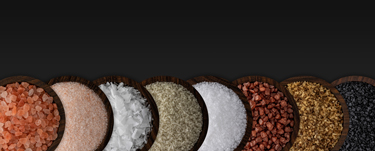
Our Gourmet Salt Guide is the ultimate gourmet sea salt reference. Learn about kosher salt, grey salt, smoked salt, Fleur De Sel and many other types of gourmet salts. We explain the distinguishing differences among these deliciously unique sea salts so you can choose the perfect gourmet sea salt for all of your cooking needs.
Bath Salt Guide
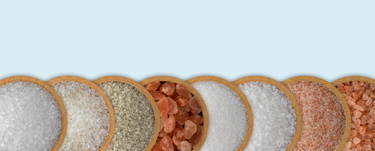
In our Bath Salt Guide, we'll guide you through the world of bath salts and explain the many benefits and differences between the wide selection of bath salts available.
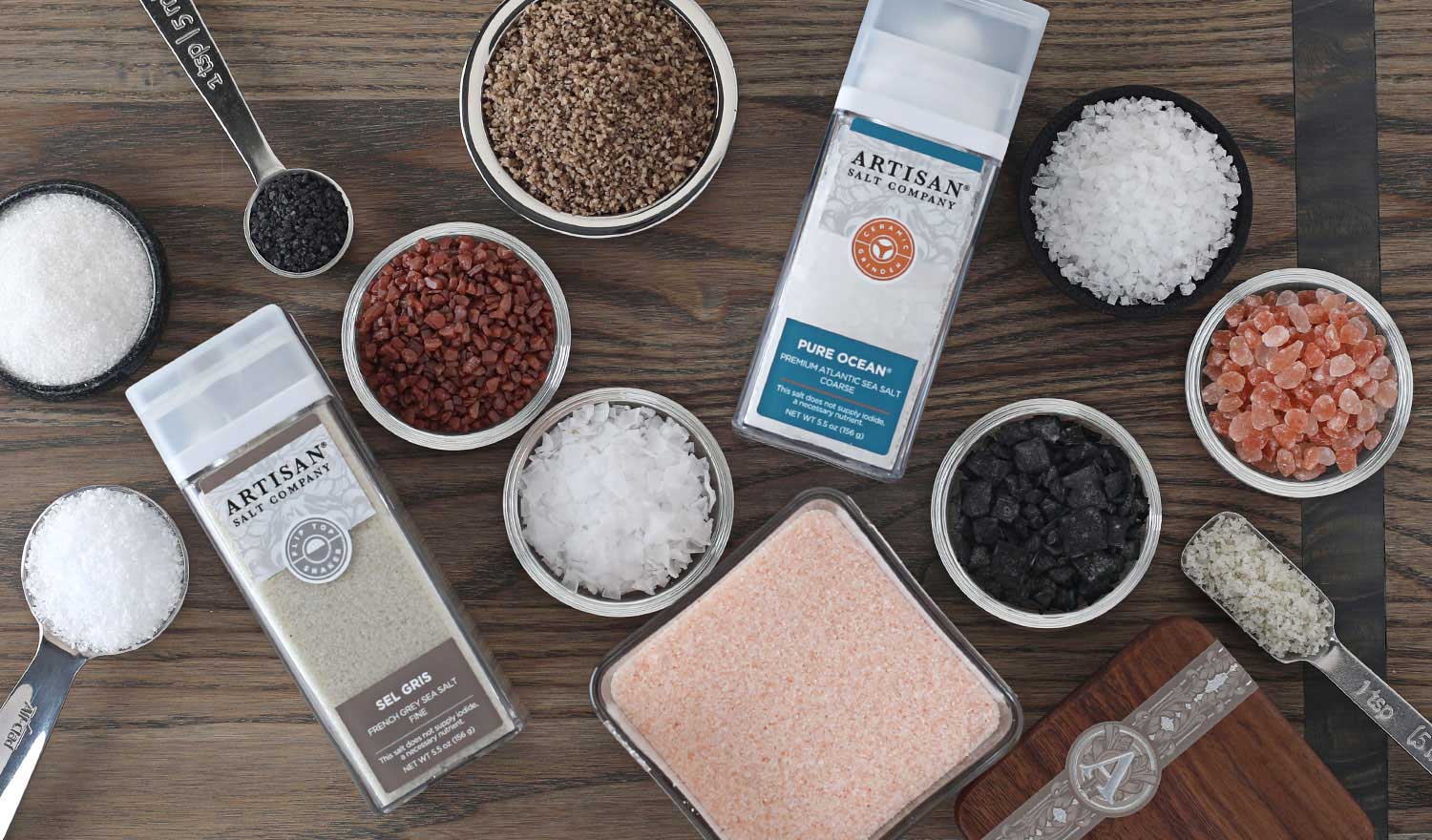
About Salt
Explore the wide world of salt: from its chemical makeup to its complex and expansive history and its many delicious, creative uses in cooking and around the house. In this section, you'll find salt guides, tips, and plenty more salt information.
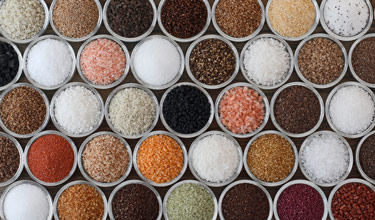
About Gourmet Salt
From Mexico to France, Southern Australia to the ancient sea beds of the Himalayans, we source the highest quality gourmet salts across the globe. In this section, you'll find our Gourmet Salt guide, plus tips to use flavored salts and smoked salts.
Salt Information
Salt is more than a simple seasoning. Even before recorded history, salt has played an important role in religion, global trade and commerce and, of course, cooking. In ancient Rome, salt was so highly valued that it was worth its weight in gold and was used as payment to soldiers. (In fact, the word "salary" derives from the Latin word for salt.)
Travel with Salts from Around the World
From salt deposits in ancient sea beds high up in the Himalayas to famous salt ponds in Brittany, France, we have salts from all over the world. Our all-natural sea salts are harvested from waters all over the globe—from the Atlantic Ocean to the Pacific, to the pristine waters of the Southern Ocean.
You can travel to France with a sprinkle of grey sea salt, or taste the tropical waters of South America with a pinch of Mayan Sun. Make a Mexican feast or add the flavor of Hawaii to kalua pork, all in the comfort of your kitchen with our range of specialty salts. Add any of our varieties of Dead Sea bath salts to your next soothing soak and be transported to Israel (without paying a hefty airfare!).
Salts are harvested in different ways. Ocean waters are funneled into ponds allowing the sea water to slowly evaporate under the sun, leaving behind pure sea salt. Sea salts are often harvested by hand with the same methods and tools as have been used for centuries. Some salts "bloom" on top of ponds and are gently, carefully pulled from the water. These unique, young crystals are often called the "caviar of salt."
How and where salt is harvested affects its color, taste, texture and mineral content. Salts range in color from pure white to pink, gray to dark red and even black (with the addition of activated charcoal.
Sea Salt, Table Salt, Mineral Salt, Rock Salt...What's the Deal with All These Salts?
Salt is a chemical compound of a base and an acid and comes in many forms. The most well-known, of course, is salt: Sodium Chloride (NaCl). Different base/acid combinations make different types of salt: magnesium sulfate (Epsom Salt), sodium carbonate (baking soda), magnesium chloride (road deicer), sodium nitrate (smoke bombs, rocket propellant), potassium nitrate (gunpowder), and so on.
The sodium in salt is an essential dietary element for humans, animals and even some plants. Natural and unrefined sea salts and mineral salts (aka "rock salts") also contain trace amounts of minerals like potassium, magnesium, calcium, sulfur, phosphorous, bromine, zinc and iron.
Table salt is chemically refined (stripped of its trace minerals) and is almost always mixed with anticaking agents which often contain aluminum and silicon.
Though it can still season your food, pure sodium chloride just doesn't live up to the potential of natural sea salt in taste, texture or rich trace mineral content.
Cooking with Salt
In addition to using salt for trade and currency, Romans also seasoned their fresh greens and vegetables with salt. Salt also remains one of the oldest and most effective preservatives. Indeed, the words "sauce" and "sausage" are also derived from the word salt. Before modern technological advancements to process and can foods, salt was essential for curing meats and fish, and extending the life of other perishable foods.
Salt can help you get a savory crust on seared meats while also making tougher cuts more tender by breaking down proteins. It helps tighten the gluten structure of breads, aids the caramelization of sautéed veggies and enhances the overall flavor of a dish.
A salt's salinity, taste, texture, aroma and color depends on where it's harvested and how it is processed. These differences make salt truly integral to every step of the cooking process and every recipe. Moist, crunchy, coarse crystals are ideal for roasting and grilling because they help to retain meat's juicy flavor and moisture throughout a long cooking process. Flake salts, on the other hand, dissolve quickly and are ideal for baking and everyday cooking when you don't have a lot of time to wait around as the salt dissipates.
Flakier salts have a delicate but noticeable crunch, making them a good way to finish different recipes too. A sprinkle of a large flake salt on a caramel, for example, gives a crunchy contrasting texture to the smooth, chewy candy and just a pop of salt before it quickly dissolves on your tongue. Fine grain salts are versatile, perfect for everyday use and utilitarian tasks like salting pasta water or using in your salt shaker on the dinner table. Velvet powder-like grains of salt adheres beautifully to snack foods, perfect for coating tortilla chips, roasted nuts and especially on popcorn.
Salt in the Bath
Epsom salts and sea salts can be used in the bath to soothe sore muscles, help you relax (especially when blended into scented bath salts with essential oils like lavender and vanilla), offer relief from dry skin or other ailments and even help to draw toxins from the body. Your skin is, after all, the largest organ of the body.
You can add a few cups of salt to your bath, or get creative. Unscented bath salts can be used to make exfoliators, scrubs or even soaps and lotion. You can mix bath salts with dried herbs, flower buds or petals and essential oils in a muslin or disposable sachet to make a bath tea. The salts will dissolve while the flowers and herbs will scent the water.

